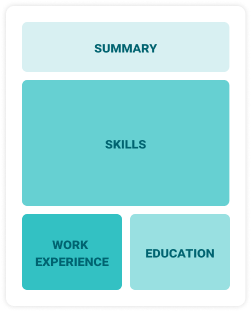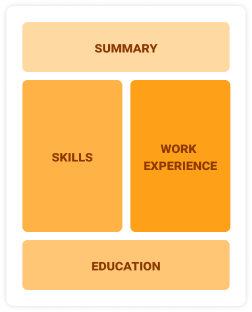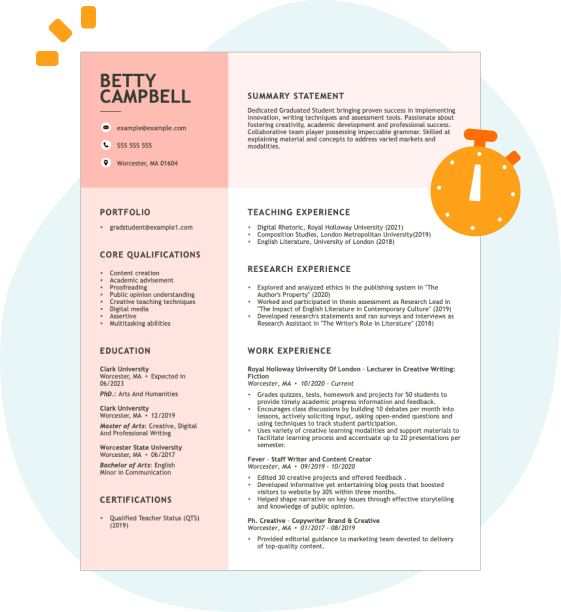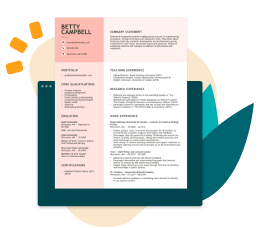When discussing hard skills, it is important to include skill in electronic health records, care plan development, and patient scheduling systems that ensure efficient coordination of patient services.
Popular Patient Care Coordinator Resume Examples
Discover our top patient care coordinator resume examples that emphasize key skills such as communication, organization, and problem-solving. These examples will guide you in showcasing your accomplishments effectively to potential employers.
Ready to make your resume shine? Our Resume Builder offers user-friendly templates specifically designed for healthcare professionals, helping you create a standout application with ease.
Entry-level patient care coordinator resume
This entry-level resume effectively highlights the job seeker's strong background in patient care coordination and healthcare management, showcasing their achievements in improving patient satisfaction and streamlining operations. New professionals must display a mix of relevant skills, successful projects, and proactive engagement in healthcare initiatives to reassure employers of their capability despite limited experience.
Mid-career patient care coordinator resume
This resume clearly presents key qualifications that show the applicant's readiness for advanced responsibilities. Emphasis on measurable achievements and leadership roles illustrates a strong trajectory in patient care management, showcasing both operational expertise and commitment to quality improvement.
Experienced patient care coordinator resume
The work history section demonstrates the applicant's effectiveness as a patient care coordinator, highlighted by achievements such as increasing patient satisfaction by 20% and streamlining appointment scheduling by 25%. The clear formatting allows hiring managers to quickly assess relevant accomplishments and skills.
Resume Template—Easy to Copy & Paste
Suki Chen
Lakeside, CA 92059
(555)555-5555
Suki.Chen@example.com
Skills
- Patient Care Excellence
- Healthcare Management
- Data Analysis
- Medical Records Coordination
- Scheduling Efficiency
- Communication Skills
- Problem Solving
- Time Management
Certifications
- Certified Healthcare Professional - American Health Association
- Advanced Patient Care - Healthcare Improvement Institute
Languages
- Spanish - Beginner (A1)
- French - Intermediate (B1)
- Mandarin - Beginner (A1)
Professional Summary
Expert Patient Care Coordinator enhancing patient satisfaction and care plans through strategic management. Proven track record in healthcare efficiency and data analysis.
Work History
Patient Care Coordinator
Greenfield Hospital - Lakeside, CA
June 2024 - December 2025
- Optimized patient data by 25% efficiency
- Improved response rate in patient queries by 40%
- Coordinated care plans for 200+ patients monthly
Healthcare Administrator
Harmony Health Center - Lakeside, CA
June 2022 - May 2024
- Led patient satisfaction improvements by 30%
- Managed inventory, reducing costs by 10K yearly
- Implemented scheduling system saving 15% time
Medical Office Assistant
Meadowbrook Clinic - Los Angeles, CA
June 2019 - May 2022
- Handled insurance claims, boosting approval rate 50%
- Streamlined appointment processes reducing waits
- Improved patient check-in navigation reducing errors
Education
Master of Health Administration Health Administration
University of Georgia Athens, Georgia
May 2019
Bachelor of Science Public Health
Georgia State University Atlanta, Georgia
May 2017
How to Write a Patient Care Coordinator Resume Summary
Your resume summary is the first thing employers see, making it important for creating a strong initial impact. As a patient care coordinator, it's essential to highlight your ability to manage patient interactions and streamline healthcare processes effectively.
In this role, you should emphasize your organizational skills, communication prowess, and familiarity with healthcare regulations. These qualifications demonstrate your readiness to improve patient satisfaction and contribute positively to the healthcare team.
To help clarify what makes an effective resume summary, here are some examples that illustrate both successful elements and common pitfalls:
Weak resume summary
I am a dedicated patient care coordinator with years of experience in the healthcare field. I wish to find a position that allows me to use my skills and contribute positively to patient outcomes. An organization that values teamwork and provides opportunities for advancement would be perfect for me. I believe I can be a great asset if given the chance.
- Contains vague language about experience without detailing specific accomplishments or skills
- Overuses personal pronouns, making it more about the job seeker than their value to potential employers
- Emphasizes what the applicant seeks from the job rather than highlighting how they can benefit the organization
Strong resume summary
Compassionate patient care coordinator with over 6 years of experience in managing patient flow and optimizing care delivery in busy healthcare environments. Improved patient satisfaction scores by 20% through implementation of tailored care plans and effective communication strategies. Proficient in case management, health informatics, and fostering collaborative relationships with healthcare providers to improve patient outcomes.
- Begins with a clear indication of years of experience and role focus
- Highlights a quantifiable achievement that reflects direct impact on patient satisfaction
- Emphasizes relevant skills that demonstrate the applicant's competency in coordinating care effectively
PRO TIP
Showcasing Your Work Experience
The work experience section is important for your resume as a patient care coordinator, containing the bulk of your information. Good resume templates emphasize this section to ensure it stands out.
This part should be organized in reverse-chronological order, detailing your past positions. Use bullet points to convey your key achievements and responsibilities in each role clearly.
To further clarify what makes an effective work history section, we’ll provide a couple of examples that illustrate best practices for patient care coordinators. These examples will highlight what works well and what should be avoided:
Patient Care Coordinator
HealthFirst Medical Center – Orlando, FL
- Assisted patients with scheduling
- Communicated with healthcare providers
- Maintained patient records
- Addressed patient inquiries
- Lacks specific employment dates
- Bullet points are overly general and do not highlight unique skills or achievements
- Emphasizes routine tasks rather than compelling contributions or outcomes
Patient Care Coordinator
Health First Clinic – Orlando, FL
March 2020 - Present
- Coordinate patient care activities for a caseload of over 150 patients, ensuring timely follow-ups and reducing missed appointments by 30%
- Implement streamlined communication protocols with healthcare teams that improved information sharing and improved patient satisfaction scores by 20%
- Develop comprehensive discharge plans in collaboration with patients and families, resulting in a 15% decrease in readmission rates within the first year
- Starts each bullet point with strong action verbs to clearly convey achievements
- Incorporates specific metrics that demonstrate the job seeker's effectiveness and improvements
- Highlights essential skills related to patient coordination and teamwork across healthcare settings
While your resume summary and work experience are important components, don’t overlook the importance of other sections. Each part plays a role in presenting your qualifications effectively. For detailed guidance, refer to our comprehensive guide on how to write a resume.
Top Skills to Include on Your Resume
A skills section is important for your resume as it allows you to showcase your qualifications at a glance. This highlights your suitability for the role and captures the attention of hiring managers quickly.
For a patient care coordinator, highlight both interpersonal and technical skills. Emphasize strong communication, empathy, and problem-solving abilities, while also noting your familiarity with electronic health record systems, scheduling software, and communication platforms that help streamline patient interactions and support efficient care coordination.
In contrast, soft skills encompass strong communication, empathy, and problem-solving abilities that are essential for fostering trust and collaboration among patients and healthcare teams.
When selecting skills for your resume, it's important to align them with what employers expect. Many organizations use automated screening systems that filter out applicants lacking essential resume skills.
To improve your chances of being noticed, carefully review job postings to identify which skills are most relevant. This not only helps attract the attention of recruiters but also ensures you meet the criteria set by ATS systems.
PRO TIP
10 skills that appear on successful patient care coordinator resumes
Improve your resume to attract recruiters by showcasing the most sought-after skills for patient care coordinators. Our resume examples highlight these essential abilities, giving you the confidence needed to apply effectively.
Here are 10 skills you should consider including in your resume if they align with your experience and job requirements:
Patient advocacy
Communication
Time management
Problem-solving
Knowledge of healthcare regulations
Data entry skill
Empathy and compassion
Organizational skills
Team collaboration
Experience with patient scheduling
Based on analysis of 5,000+ nursing professional resumes from 2023-2024
Resume Format Examples
Choosing the right resume format is important for a patient care coordinator because it highlights your relevant skills and experience, showcasing your professional growth to potential employers.
Functional
Focuses on skills rather than previous jobs

Best for:
Recent graduates and career changers with limited experience in healthcare
Combination
Balances skills and work history equally

Best for:
Professionals highlighting their coordination expertise and growth potential
Chronological
Emphasizes work history in reverse order

Best for:
Seasoned experts leading complex patient care initiatives
Frequently Asked Questions
Should I include a cover letter with my patient care coordinator resume?
Absolutely. Including a cover letter is an excellent way to showcase your personality and highlight relevant skills that may not be evident in your resume. It offers a chance to connect with employers on a personal level. If you need assistance, our guide on how to write a cover letter can help, or try our Cover Letter Generator for quick and easy creation.
Can I use a resume if I’m applying internationally, or do I need a CV?
When applying for jobs abroad, use a CV instead of a resume in most cases. A CV provides a comprehensive view of your academic and professional history. Explore our resources on how to write a CV for guidance on formatting and crafting an effective document that aligns with international expectations. Additionally, reviewing CV examples can offer valuable insights into creating a compelling presentation of your experience.
What soft skills are important for patient care coordinators?
Soft skills like communication, problem-solving, and empathy are essential for patient care coordinators. These interpersonal skills foster trust and collaboration among patients, families, and healthcare teams, ensuring that care plans are effectively implemented and that patients feel supported throughout their healthcare journey.
I’m transitioning from another field. How should I highlight my experience?
Highlight your transferable skills such as communication, organization, and empathy. These abilities demonstrate your readiness for the patient care coordinator role, even if your background isn't in healthcare. Share specific instances from previous jobs that illustrate how you successfully managed projects or supported teams, connecting those experiences directly to the responsibilities of patient care coordination.
How do I write a resume with no experience?
If you’re writing a resume with no experience to apply for a patient care coordinator position, highlight relevant coursework, internships, or volunteer roles. Showcase your organizational skills, attention to detail, and ability to communicate effectively with patients and healthcare teams. Your passion for patient advocacy will resonate with employers and demonstrate your potential to excel in this role.
How do I add my resume to LinkedIn?
To boost your resume's visibility on LinkedIn, you can add your resume to LinkedIn by uploading it to your profile or highlighting essential achievements in the "About" and "Experience" sections. This approach ensures that healthcare recruiters can easily discover skilled patient care coordinators like you, improving your chances of connecting with potential employers.







